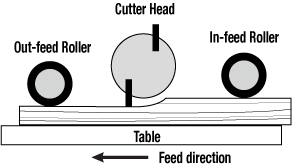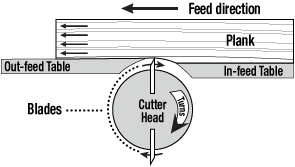Woodworking Machines - Jointers and Planers
On this page
What should you do before using jointers and planers?
Back to topJointers and planers can be dangerous if not used properly.
- Read the owner's manual carefully.
- Make sure you understand instructions before attempting to use any tool or machine.
- Learn the applications and limitations before use.
Refer to the OSH Answers on Woodworking Machines - General Safety Tips for general safety precautions.
What should you check before starting your machine?
Back to top- Are the knives set for the proper clearance and depth of cut? Are they sharp, balanced, and fastened securely?
- Is the fence anchored in the proper position?
- Can the guard (swing or overhead) move freely and return over the cutting head?
- Is the equipment properly lubricated?
- Are the parts or accessories in proper working condition?
What safety procedures should you follow when using jointers and planers?
Back to top- Wear safety glasses with side shields or safety goggles, or a face shield (with safety glasses or goggles).
- Wear hearing protection that is suitable for the level and frequency of the noise you are exposed to in the woodworking area.
- Wear protective footwear when required.
- Allow only experienced and trained personnel to operate jointers and planers.
- Use only sharp, balanced and joined knives.
- Replace old square cutting heads with round heads because they are much safer.
- Ensure start and stop buttons are within easy and convenient reach of the operator.
- Make sure the swing (self-closing) guard pushes beside the stock as it passes over the cutting heads and returns against the fence after the stock is removed.
- Make sure fences and any other guards are in place before using the machine.
- Remove all wrenches and tools used in the setup from the table.
- Provide a minimum clearance of at least 1 m (3 ft) greater than the length of the longest stock being worked.
- Construct hold-down push blocks for bevelling and surface operations. For more information, see the OSH Answers on Woodworking Machines—Push Sticks.
- Use hold-down (double-handed) push blocks. These keep hands well away from the cutting head.
- Maintain an adequate amount of downward and forward force with push blocks as the knife blades on a revolving cutting head can take the stock from an operator's hands.

Figure 1 - Planer

Figure 2 - Jointer
What should you avoid when using a jointer or planer?
Back to top- Do not cut stock that has loose knots, splits, defects or foreign objects (e.g., metal, stone) in it.
- Do not leave the machine running unattended. Before leaving the area, shut off the power and make sure that the cutting head has stopped revolving.
- Do not make cuts deeper than .3 cm (1/16 inch) in one pass.
- Do not join (edge) stock of pieces less than 30 cm (12 inches) long, 2 cm (3/4 inch) wide and less than .6 cm (1/4 inch) thick.
- Do not surface stock less than 30 cm (12 inches) long, 2 cm (3/4 inch) wide or more than 15 cm (6 inches) wide or less than 1.5 cm (5/8 inch) thick.
- Do not pass hands near or over the cutters.
- Do not remove dust or wood particles from a table by hand or with compressed air. Use a stick or brush.
- Do not wear loose clothing, work gloves, neckties, rings, bracelets or other jewellery that can become entangled with moving parts.
- Fact sheet confirmed current: 2025-03-10
- Fact sheet last revised: 2019-07-02

